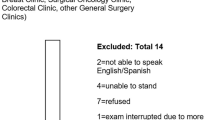Abstract
Purpose
The advantages offered by structured reporting have already been highlighted in the literature. However, there is still no evidence on the validity of this reporting method for the study of abdominal wall defects. This study aims to show the experience of the Trentino Hernia Team (THT) multidisciplinary group in the development and use of a structured CT scan report for the study of abdominal wall defects.
Methods
A regional multidisciplinary team (THT group) used a Delphi method to identify and select the most important CT scan parameters needed to describe and stage abdominal wall defects for correct preoperative planning. Based on the selected parameters, a CT scan structured report was worked out and collectively accepted. The first 20 structured reports obtained were individually tested for compilation speed and homogeneity of the data reported by five distinct radiologists. The reports were then evaluated by five different surgeons to test the simplicity of interpretation.
Results
We produced a model of a structured report for the study of the abdominal wall defects and tested it in our hospital network on the first 20 reports. The average completion time was 18 min (range 12–25). There was no heterogeneity among the reported data. The reports were analysed by five distinct surgeons to evaluate completeness and simplicity of interpretation. Each surgeon used a Likert scale from 0 to 5 to evaluate each report, producing average scores of 4.8 and 4.1 for completeness and comprehensibility respectively, with a mean combined total score of 8.9 out of 10.
Conclusions
Our structured report represents a fundamental tool capable of providing the surgeon with all the measurements of the parameters necessary for correct preoperative planning. At the same time, it is of crucial help for the radiologists representing an easy and fast way to report all the needed parameters using the same standards.





Similar content being viewed by others
Availability of data and material
Not applicable.
Code availability
Not applicable.
References
Sanders DL, Kingsnorth AN (2012) The modern management of incisional hernias. BMJ 344:e2843
Malviya A, Patel A, Bhardwaj G, Bulchandani HP, Saini V (2017) A comprehensive study on the incidence and management of incisional hernia. Int Surg J 4(7):2303–2307
Cassar K, Munro A (2002) Surgical treatment of incisional hernia. Br J Surg 89:534–545
Mudge M, Hughes LE (1985) Incisional hernia: a 10 year prospective study of incidence and attitudes. Br J Surg 72(1):70–71
Kroese LF, Gillion J-F, Jeekel J, Kleinrensink G-J, Lange JF (2018) Primary and incisional ventral hernias are different in terms of patient characteristics and postoperative complications—a prospective cohort study of 4,565 patients. Int J Surg 5:114–119. https://doi.org/10.1016/j.ijsu.2018.01.010
Mommers EHH, Ponten JEH, Al Omar AK, de Vries Reilingh TS, Bouvy ND, Nienhuijs SW (2017) The general surgeon’s perspective of rectus diastasis. A systematic review of treatment options. Surg Endosc 31(12):4934–4949. https://doi.org/10.1007/s00464-017-5607-9
Reinpold W, Köckerling F, Bittner R, Conze J, Fortelny R, Koch A, Kukleta J, Kuthe A, Lorenz R, Stechemesser B (2019) Classification of rectus diastasis—a proposal by the German Hernia Society (DHG) and the International Endohernia Society (IEHS). Front Surg 6:1. https://doi.org/10.3389/fsurg.2019.00001
Köhler G, Luketina RR, Emmanuel K (2015) Sutured repair of primary small umbilical and epigastric hernias: concomitant rectus diastasis is a signifcant risk factor for recurrence. World J Surg 39:121–126
Gossetti F, D’Amore L, Ceci F, Grimandi MR, Nego P (2017) Abdominal wall reconstruction (AWR): the need to identify the hospital units and referral centers entitled to perform it. Updates Surg 69:289–290
Reynolds D, Davenport DL, Korosec RL, Roth JS (2013) Financial implications of ventral hernia repair: a hospital cost analysis. J Gastrointest Surg 17:159–166
Government, US (2009) XIII: Health Information Technology: Health Information Technology for Economic and Clinical Health Act (HITECH Act). American Recovery and Reinvestment Act of 2009, pp 112–164
Carrara A, Lauro E, Fabris L, Frisini M, Rizzo S (2018) Endo-laparoscopic reconstruction of the abdominal wall midline with linear stapler, the THT technique. Early results of the first case series. Ann Med Surg (Lond) 12:1–7
Jaffe TA, O’Connell MJ, Harris JP, Paulson EK, DeLong DM (2005) MDCT of abdominal wall hernias: is there a role for Valsalva’s maneuver? Am J Roentgenol 184:847–851
Muysoms FE, Miserez M, Berrevoet F et al (2009) Classification of primary and incisional abdominal wall hernias. Hernia 13:407–414
Reinpold W, Köckerling F, Bittner R, Conze J, Fortelny R, Koch A, Kukleta J, Kuthe A, Lorenz R, Stechemesse B (2019) Classification of rectus diastasis—a proposal by the German Hernia Society (DHG) and the International Endohernia Society (IEHS). Front. Surg. 6:1. https://doi.org/10.3389/fsurg.2019.00001
Love MW, Warren JA, Davis S, Ewing JA, Hall AM, Cobb WS, Carbonell AM (2020) Computed tomography imaging in ventral hernia repair: can we predict the need for myofascial release? Hernia. https://doi.org/10.1007/s10029-020-02181-y
Christy MR, Apostolides J, Rodriguez ED, Manson PN, Gens D, Scalea T (2012) (2012) Reconstruction, the component separation index: a standardized biometric identity in abdominal wall. Eplasty 12:e17
Nobel JM, Kok EM, Robben SGF (2020) Redefining the structure of structured reporting in radiology. Insights Imaging. https://doi.org/10.1186/s13244-019-0831-6
European Society of Radiology (2018) ESR paper on structured reporting in radiology. Insights Imaging 9(1):1–7. https://doi.org/10.1007/s13244-017-0588-8
Funding
No funding was required in the writing of this paper.
Author information
Authors and Affiliations
Contributions
All authors equally contributed to this work in designing it, collecting data, writing the paper and review it.
Corresponding author
Ethics declarations
Conflict of interest
No conflict of interests to be declared.
Ethics approval
The study was approved by our ethical committee (Ref. N.10/2020 - 14/12/2020).
Informed consent
All patients regularly signed informed consent for Ct scan examination.
Consent to participate
Not applicable.
Consent for publication
Not applicable.
Additional information
Publisher's Note
Springer Nature remains neutral with regard to jurisdictional claims in published maps and institutional affiliations.
Rights and permissions
About this article
Cite this article
Carrara, A., Nava, F.L., Costa, M. et al. CT scan structured report for the study of abdominal wall defects: a fast, easy and practical tool at the service of both surgeons and radiologist. Hernia 25, 1685–1692 (2021). https://doi.org/10.1007/s10029-021-02503-8
Received:
Accepted:
Published:
Issue Date:
DOI: https://doi.org/10.1007/s10029-021-02503-8




